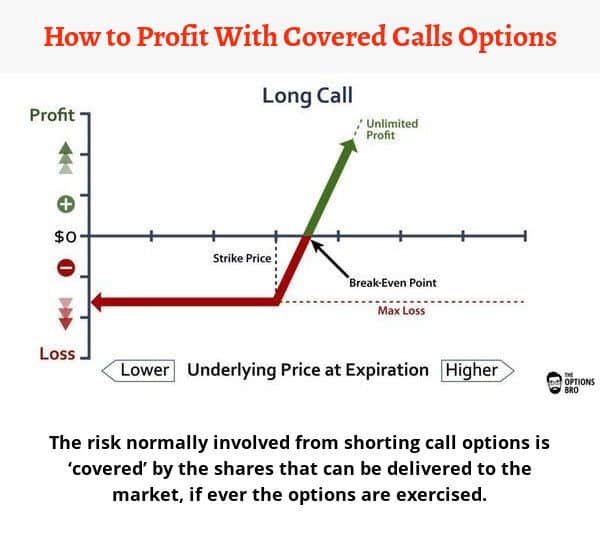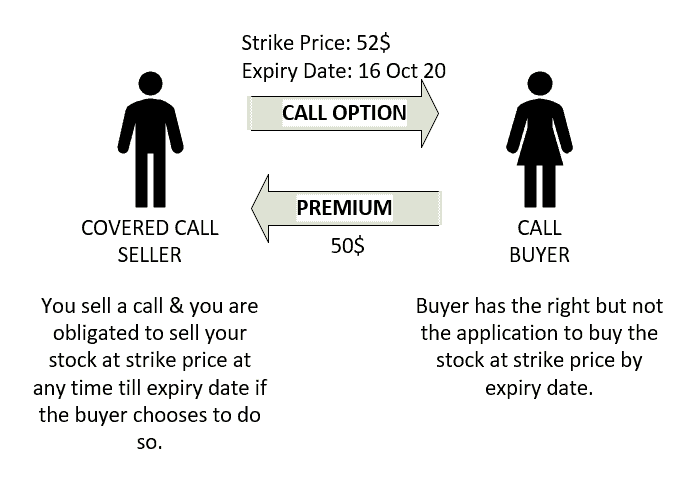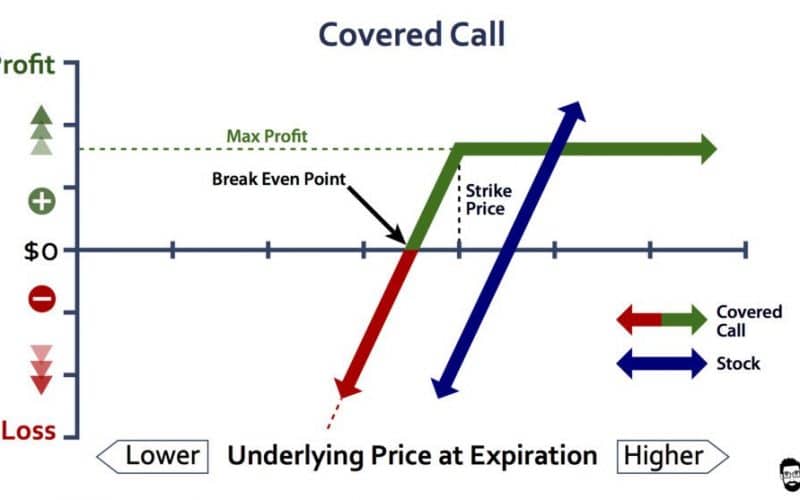Covered call options are one aspect of the options trading that cannot be undermined. New investors need to be abreast on what is covered call option strategy, selling cover call options, and also writing covered call options. This article will guide you on all of these listed above, not forgetting also covered call option screeners.

Keep reading, you will be amazed about the information that will be shared here.
In other not to waste your time, let’s get started by first knowing what are covered call options. Shall we?
What Are Covered Call Options?
A covered call is an options tactic that involves trade in both the underlying stock and options contract. The investor buys or owns the underlying stock or asset. They then sell their Call Options- the right to purchase the underlying asset. And they wait for the contract of the option to be exercised or to expire.
Also, a covered call option is a financial transaction in which the trader selling call options owns an equivalent sum of the underlying security. To execute this, an investor holding a long position in an asset then writes (sells) call options on that same asset to produce an income stream.
However, if the investor simultaneously buys a stock and writes call options against that stock position, it is called a “buy-write” transaction. Covered calls can also be applied in achieving income on the stock above and beyond any dividends. The aim in this scenario is for the options to expire worthlessly.
Now let’s take a look at covered call option strategy
Covered Call Options Strategy
A covered call options strategy is not helpful for a very bullish nor a very bearish investor. Indeed, If a trader is very bullish, it is better they do not write the option and just hold the stock. The option caps the profit on the stock, which could lessen the total profit of the trade if the stock price goes up.
Likewise, if a trader is extremely bearish, it will be better off for him to simply sell the stock. Since the premium got for writing a call option will do almost nothing to offset the loss on the stock if the stock falls.

Selling the call obligates investors to sell stock they already own at a strike price if the option is assigned. Some traders will run this strategy after they have already seen pleasant gains on the stock. Often, they will sell out-of-the-money calls, so if the stock price goes up, they are not reluctant to part with the stock and take the profit.
If investors buy stock and sell the calls simultaneously, it’s called a ”Buy / Write.” Some traders use a Buy / Write as a means of reducing the cost basis of a stock they have just purchased.
However, the call that is sold is basically out of the money (OTM), when an option’s strike price is higher than the market price of the underlying asset. This profit can be made on both the option contract sale and the stock if the stock price stays below the strike price of the option.
Selling Covered Call Options
Selling covered calls is a means by which traders write a call option contract and at the same time owning an equivalent number of shares of the underlying stock. When a trader sells a covered call, he gets paid for giving up a portion of future upside.
Lookup for when to sell your covered call
Now let us talk about mistakes people often make when selling covered call options.
Mistakes You Must Avoid When Selling Covered Call Options
Here is the sad truth, Not all traders eventually succeed in creating a profitable portfolio. Most times, it is due to the uncertainty in the market or various other factors, but more often new investors fail because of these various mistakes that will be discussed below.
Selling at the Wrong Strike Price or Expiration
In the world of options trading, strategy is everything and everything is strategy. One big mistake newbies make is deciding to sell calls at the wrong strike price or expiration, without knowing the risks and rewards involved with each selling strategy.
The strike price of an option refers to the price at which a call option can be exercised. It has an immense bearing on how profitable your investment will be. When choosing the right strike price, you must put into consideration the risk involved as well as your expected payoff.
Selling Naked Instead of Covered Call Options
When selling covered calls, the highest profit you can receive is referred to as the premium. In a case where the underlying asset increases significantly in price, the trader might lose largely if they do not own the shares.
An investor owning the stock he is writing an option on is referred to as writing a covered call. However, If he does not own the stock or underlying security, it is called writing a naked call.
A naked call strategy is obviously risky. Hence a limited upside potential and an almost unlimited downside potential should the trade go against the investor.
Not Taking Dividends Into Consideration
Another mistake that investors make when evaluating option prices, they do not take dividends into account before selecting the right stock.
Dividend payments prior to expiration affect the call premium. The stock price is expected to reduce by the dividend payment on the ex-dividend date. Hence, call premiums will be lower, and put premiums will be higher. Dividend payments are also a good reason why call buyers are to exercise their option early.
Not Having The Plan Of Managing Loss
In every business, there is profit and there are sometimes losses incurred. As an investor, whether you like it or not you will one-day face loss. You just have to be prepared for unforeseen circumstances. Sometimes trade can move against you.
No one wants a trade to go bad. However, you must be prepared for a loss and find ways to manage risk. This entails outlying how much money you are willing to risk before placing a trade, and how you will bail out of trade goes south. Hence, knowing exactly when to cut your losses.
Expecting Immediate Returns
Finally, investors should know that options trading is not a Ponzi scheme. They should be prepared to invest for the long run and not expect immediate returns. In Spite of the fact that options trading can be highly profitable. However, nothing is guaranteed and it is in no way, shape or form a “get rich quick” strategy.
It takes time to see the returns you desire. A realistic goal would be to aim for around 10-12% return on your investments per year.
Having known this, let’s discuss brief writing a covered call option
Writing A Covered Call Option
Writing a covered call refers to selling someone else the right to purchase a stock that you own, at a specific price and within a stated time frame. One call option contract usually denotes 100 shares. Hence, to run this strategy, investors must own at least 100 shares for every call contract they plan to sell.
Basically, the investor gets a premium for writing the call options. But if the price of the underlying security falls, the options only protect the investor in an amount equivalent to the premium received.

However, writing call options can be a good tactic for traders who are bullish enough to risk stock ownership. But must also not be so bullish that they anticipate a large price increase.
Writing a cover call has some advantages and also some potential setbacks. Let us take a look at some of them.
Advantages
Income:
Investors receive the option premium by selling one call option for every 100 shares of stock owned. The money is for the investor, no matter what happens in the future.
Safety:
Any premium received by the investors offers the stockholder limited protection against a loss in a case where the stock price reduces.
Disadvantages
Capital gains:
Investors writing a covered call limits their profits. Their maximum selling price usually becomes the strike price of the option. Indeed, they get to add the premium received to the sale price. However, if the stock rises sharply, the covered call writer loses out on the possibility of a big profit.
Flexibility:
As long as an investor sells the call, but it has neither expired nor been covered, he cannot sell his stock. Doing so would leave him “naked short” the call option.
Covered Call Options Screeners
The phrase “Covered call option screeners” is a common phrase. However, some newbies might not know its meaning. So, do me the honor to give you a brief meaning.
A Covered Call Screener is basically the software that allows an investor to select his stock and options for the covered call. However, it is based on the criteria he specifies using filters.
The issue here is knowing the filters to use when setting up a covered call option. So let’s discuss some of these filters.
Stock – This can be P/E ratios, all sorts of Implied and historical volatility measures, dividend ratios, prices among others.
Timeframe – how long in the future does an investor want to look for selling his call?
Trade – investors can set minimum goals for the trade such as the probability of profit, delta, or theta.
Option – IT refers to the type of options the investor needs. Does he want to specify bid-ask spreads, open interest, or a specific delta perhaps?
Conclusion
Finally, we have come to a conclusion that covered call options strategies are a crucial aspect of options trading.
Covered call options FAQ
What are covered calls in options?
A covered call is an options tactic that involves trade in both the underlying stock and options contract. The investor buys or owns the underlying stock or asset. They then sell their Call Options
Is covered call a good strategy?
A covered call options strategy is not helpful for a very bullish nor a very bearish investor. Indeed, If a trader is very bullish, it is better they do not write the option and just hold the stock. The option caps the profit on the stock, which could lessen the total profit of the trade if the stock price goes up.
Related Article






